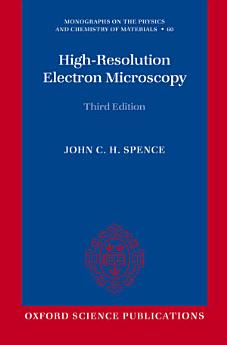High-Resolution Electron Microscopy: Edition 3
Oct 2008 · Monographs on the Physics and Chemistry of Materials Book 60 · OUP Oxford
Ebook
424
Pages
family_home
Eligible
info
reportRatings and reviews aren’t verified Learn More
About this ebook
The discovery of the Nanotube in 1991 by electron microscopy has ushered in the era of Nanoscience. The atomic-resolution electron microscope has been a crucial tool in this effort. This book gives the basic theoretical background needed to understand how electron microscopes allow us to see atoms, together with highly practical advice for electron microscope operators. The book covers the usefulness of seeing atoms in the semiconductor industry, in materials science (where scientists strive to make new lighter,stronger, cheaper materials), and condensed matter physics (for example in the study of the new superconductors). Biologists have recently used the atomic-resolution electron microscope to obtain three-dimensional images of the Ribosome, work which is covered in this book. The books also shows how the ability to see atomic arrangements has helped us understand the properties of matter. This new third edition of the standard text retains the early section of the fundamentals of electron optics, linear imaging theory with partial coherence and multiple-scattering theory. Also preserved are updated earlier sections on practical methods, with detailed step-by-step accounts of the procedures needed to obtain the highest quality images of the arrangement of atoms in thin crystals using a modern electron microscope. The sections on applications of atomic resolution transmission electron microscopy (HREM) have been extensively updated, including descriptions of HREM in the semiconductor industry, superconductor research, solid state chemistry and nanoscience, as well as metallurgy, mineralogy, condensed matter physics, materials science and biology. Entirely new sections have been added on electron holography , aberration correctors, field-emission guns, imaging filters, HREM in biology an don organic crystals,super-resolution methods, Ptychography, CCD cameras and Image plates. New chapters are devoted entirely to scanning transmission electron microscopy and Z-contrast, and also to associated techniques, such as energy-loss spectrocospy, Alchemi, nanodiffraction and cathodoluminescence. Sources of software for image interpretation and electron-optical design are also given.
About the author
John Spence is a Fellow of the American Physical Society and of the Institute of physics, a recent co-editor of Acta Crystallographica and serves on the editorial board of Reports on Progress in Physics. He also serves on the Scientific Advisory Committee of the Molecular Foundary and the Advanced Light Source at the Lawrence Berkeley Laboratory. He is a member of the International Union of Crystallography's Commission on Electron Diffraction, and winner of the Burton award of the Microscopy Society of America.
Rate this ebook
Tell us what you think.
Reading information
Smartphones and tablets
Install the Google Play Books app for Android and iPad/iPhone. It syncs automatically with your account and allows you to read online or offline wherever you are.
Laptops and computers
You can listen to audiobooks purchased on Google Play using your computer's web browser.
eReaders and other devices
To read on e-ink devices like Kobo eReaders, you'll need to download a file and transfer it to your device. Follow the detailed Help Center instructions to transfer the files to supported eReaders.










